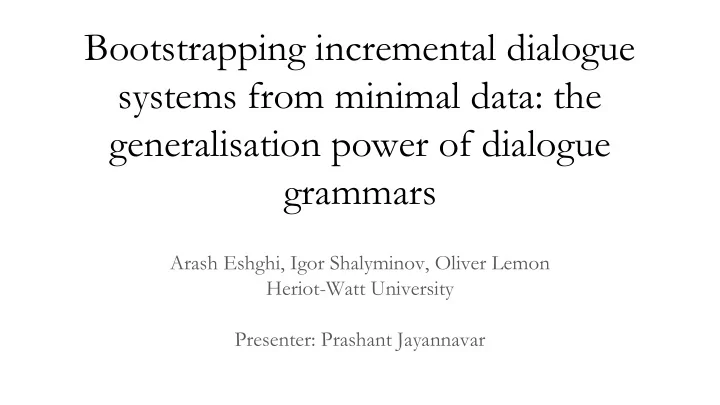

Bootstrapping incremental dialogue systems from minimal data: the generalisation power of dialogue grammars Arash Eshghi, Igor Shalyminov, Oliver Lemon Heriot-Watt University Presenter: Prashant Jayannavar
Problem - Inducing task-based dialog systems - Example: Restaurant search
Motivation - Poor data efficiency - Annotation costs - task-specific semantic/pragmatic annotations - Lack of support for natural spontaneous dialog/incremental dialog phenomena - E.g.: “I would like an LG laptop sorry uhm phone”, “we will be uhm eight”
Contributions - Solution - An incremental semantic parser + generator trained with RL - End-to-end method - Show the following empirically: - Generalization power - Data efficiency
Background - DS-TTR parsing ( D ynamic S yntax - T ype T heory with R ecords) - Dynamic Syntax - word-by-word incremental and semantic grammar formalism - Type Theory with Records - Record Types (RTs): richer semantic representations
Background - DS-TTR parsing ( D ynamic S yntax - T ype T heory with R ecords)
BABBLE - Treat natural language generation (NLG) and dialog management (DM) as a joint decision problem - Given a “dialog state” decide what to say - Learn to do this through learning a policy ( � : S -> A) -- RL - Define “dialog state” using output of the DS-TTR parser
BABBLE - Inputs: - A DS-TTR parser - A dataset D of dialogs in target domain - Output: - Policy � : S -> A (given a “dialog state” deciding what to say)
BABBLE - MDP setup - S: set of all dialog states (induced from dataset D) - A: set of all actions (words in the DS lexicon) - G_d: Goal state - R: reaching G_d while minimizing dialog length
BABBLE - Dialog state: - Between SYSTEM and USER utterances and between every word of SYSTEM utterances
BABBLE - Dialog state: - Between SYSTEM and USER utterances and between every word of SYSTEM utterances SYSTEM: [S_0] What [S_1] would [S_2] you [S_3] like [S_4] ? [S_5 = S_trig_1] USER: A phone [S_6] SYSTEM: by [S_7] which [S_8] brand [S_9] ? [S_10 = S_trig_2] USER: …
BABBLE - Dialog state: - Between SYS and USER utterances and between every word of SYS utterances - Context up until that point in time - Context C = <c_p, c_g>
BABBLE - SYSTEM: What would you like ? USER: A phone SYSTEM: by which brand ? [S_10]
BABBLE Sys: by which brand? Sys: What would you like? Usr: a phone
BABBLE - Dialog state: - Between SYS and USER utterances and between every word of SYS utterances - Context up until that point in time - Context C = <c_p, c_g> - State encoding function F: C -> S maps context to a binary vector
BABBLE
BABBLE - Dialog state: - Between SYS and USER utterances and between every word of SYS utterances - Context up until that point in time - Context C = <c_p, c_g> - State encoding function F: C -> S maps context to a binary vector
BABBLE RL to solve the MDP SYSTEM: [S_0] What [S_1] would [S_2] you [S_3] like [S_4] ? [S_5 = S_trig_1] USER: A phone [S_6] <- Simulated User SYSTEM: by [S_7] which [S_8] brand [S_9] ? [S_10 = S_trig_2] USER: … <- Simulated User SYSTEM: …
BABBLE User simulation - Generate user turns based on context - Monitor system utterance word-by-word
BABBLE User simulation - Generate user turns based on context - Run parser on dataset D and extract rules of the form: S_trig_i -> {u_1, u_2, …, u_n} S_trig_i = a trigger state u_i = user utterance following S_trig_i in D
BABBLE SYSTEM: [S_0] What [S_1] would [S_2] you [S_3] like [S_4] ? [S_5 = S_trig_1] USER: A phone [S_6] <- Simulated User SYSTEM: by [S_7] which [S_8] brand [S_9] ? [S_10 = S_trig_2] USER: … <- Simulated User SYSTEM: …
BABBLE User simulation - Generate user turns based on context - Monitor system utterance word-by-word - After system generates a word, check if new state subsumes one of the S_trig_i - If not, penalize system and terminate learning episode
BABBLE SYSTEM: [S_0] What [S_1] would [S_2] you [S_3] like [S_4] ? USER: A phone [S_6] SYSTEM: by [S_7] which [S_8] brand [S_9] ? USER: … SYSTEM: …
Evaluation - 2 datasets to test generalization: - bAbI - Dataset of dialogs by Facebook AI Research - Goal oriented dialogs for restaurant search - API call at the end
Evaluation - bAbI+ - Add incremental dialog phenomena to bAbI - Hesitations: “we will be uhm eight” - Corrections: “I would like an LG laptop sorry uhm phone” - These phenomena mixed in probabilistically - Affect 11336 utterances in the 3998 dialogs
Evaluation - Approach to compare to (MEMN2N): - Bordes and Weston 2017: Learning end-to-end goal-oriented dialog - Uses memory networks - Retrieval based model
Evaluation - Experiment 1: Generalization from small data - Do not use the original system for a direct comparison - Use a retrieval based variant - 1-5 examples from bAbI train set - Test on 1000 examples from bAbI test set - Test on 1000 examples from bAbI+ test set
Evaluation - Experiment 1: Generalization from small data - Metric: Per utterance accuracy
Evaluation - Experiment 2: Semantic Accuracy - Metric: Accuracy of API call - BABBLE: 100% on both bAbI and bAbI+ - MEMN2N: Nearly 0 on both bAbI and bAbI+ - MEMN2N (when trained on full bAbI dataset): 100% on bAbI and only 28% on bAbI+
Summary - An incremental semantic parser + generator trained with RL - End-to-end training - Support incremental dialog phenomena - Showed the following empirically: - Generalization power - Data efficiency
Recommend
More recommend